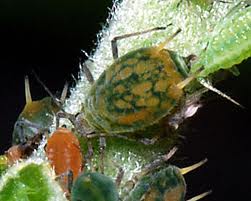How many of you realise that when you look at an aphid you are simultaneously looking at first, a clonal organism and secondly a mother, her daughter and her granddaughters, all housed in the same body? This is the wondrous phenomenon known as telescoping of generations. Aphids, except just before overwintering, give birth to live young (viviparity), and without the need of a male (asexual reproduction/parthenogenesis). Thus for most of the time when you look at an aphid, you are looking at one member of a clone i.e her sister-self-daughter. Not only that, but you are looking at not only the aphid in front of your eyes, but at her daughters and her daughter’s daughters, all of which are neatly lined up in tidy rows within the ovarioles of their respective mothers. With aphids, it is not just maternal effects you have to consider, but also grand-maternal effects, so any experiments should take into account the host-plant and environmental conditions that the ‘grand-mother’ experienced, not just those of the ‘mother’.
Reproduced from Dixon (1973)
In addition, as the eggs are hatched within the aphids before they are born, their total development time, compared with those insects that lay eggs which hatch externally to their mothers, is significantly reduced, thus giving them a head-start in the population development race. This is suggested as one of the reasons why aphids are so successful as pest insects.
Generally speaking, this wonderful world of internal generations is hidden from us, unless we cruelly dissect the clone mother and extract her ovarioles. In some aphids however, such as the small willow aphid, Aphis farinosa, where the offspring are a completely different colour from their mother, the next generation of aphids becomes clearly visible without the need to cut open the mother.
And before you ask, as far as I know, there is no evidence that the generations within a generation go on ad infinitum, like a hall of mirrors, although it would be really cool if they did.
No wonder I love aphids so much.
Dixon A.F.G. (1973) The Biology of Aphids, Edward Arnold, London
P.S. Tony Dixon’s little Biology of Aphids book is a great introduction to the subject, unfortunately out of print, but the good news is that it is still possible to buy second-hand copies for less than £5. Another great and very readable book, is Aphid Ecology, also by Tony and again out of print, except as an e-book. The really bad news is that the cheapest copy I have been able to find is priced at £43.31 prior to shipping, so if you want to read it the best option is to borrow it from the library.


